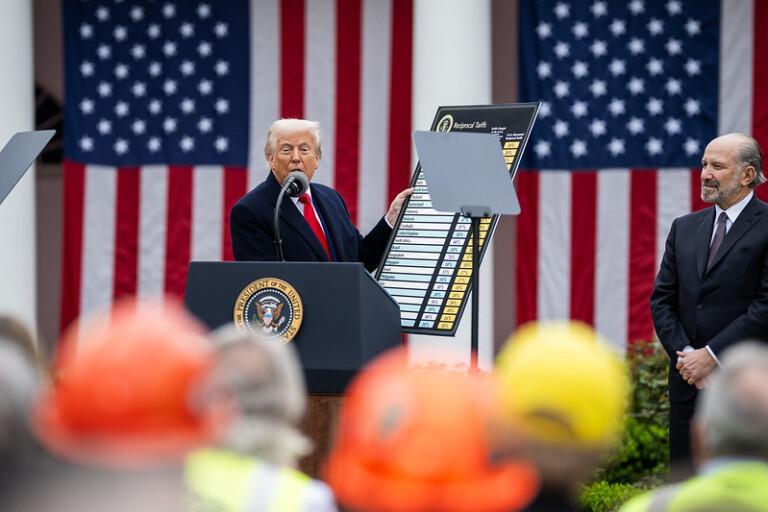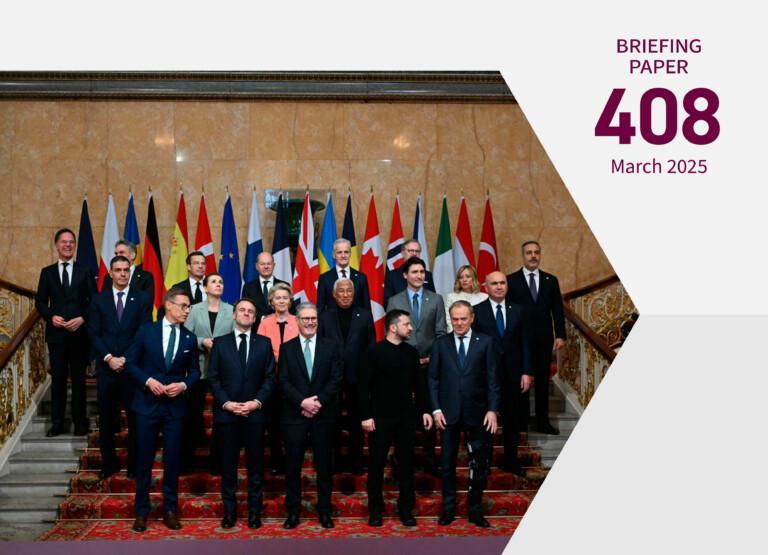
The US withdrawal from Iraq in 2011 coincided with the militarisation of the upheaval in Syria, preparing the ground for Daesh to emerge as a transnational jihadist militia.
Daesh’s cross-border territorial gains from 2014 continue to be reversed on multiple fronts in Iraq and Syria as major military campaigns are being waged in Mosul and Al-Bab, and are under preparation in Raqqa, the “capital” of the self-styled caliphate. Remarkably, Palmyra, the only place recaptured by the Syrian military itself, was retaken by Daesh in December 2016.
A huge number of actors, often with conflicting goals, are involved in the anti-Daesh offensives: the Iraqi armed forces, supporting militias and the Popular Mobilisation Units; Kurdish-dominated armed factions; the Turkish military, Russia, Iran and the multinational Operation ‘Inherent Resolve’ are all engaged in this fight.
As no terrorist movement can operate effectively without a broad range of supporters, Iraq’s political arrangements and the peace-building process in Syria will significantly determine the future Sunni stance over extremist ideas and organisations, particularly Salafi-jihadism.
Furthermore, two main issues emerge with regard to an assumed post-Daesh order: the reorientation of its fighters, including foreign fighters returning to Europe and the capability of inclusive governance to roll back sectarianism.
Daesh 1 is an apocalyptic terror outfit with no parallel in the history of the Middle East. It rivals the Taliban and the Khmer Rouge regimes in the ferocity with which it has set about building its powerbase. The zealous Islamist “End of Days” narrative, coupled with exploiting the real or perceived grievances of local Sunni populations, have held the secret to its dynamism and resilience.
Daesh managed to revive the myth and political ideal of an Islamic caliphate by recasting it as a modern story of heroism and death, utilising the aesthetics of violence. It represents an apocalyptic zeitgeist with a nihilistic twist, which Daesh has used to attract a global audience, foreign fighters and support from many Muslims around the world.
In a relatively short space of time, Daesh has managed to carve out a de facto quasi-state in the borderlands of Iraq and Syria (the Jazirah). Stretching from Fallujah in Iraq to Raqqa and beyond in Syria, Daesh controls territory, provides some basic services, dispenses justice, attracts foreign fighters to join its mercenary army, and flies its black flag on the ruins of former Iraqi and Syrian state infrastructure (see map). Daesh is leaving destruction and ruins in its wake, causing the mass exodus of ethno-religious communities across the region.
It is with these vistas in mind that this Briefing Paper examines the current state of affairs pertaining to the evolving nature of Daesh in Iraq and Syria, with a focus on the extremely precarious security situation and the role of the various players that contribute to the Hobbesian “war of all against all”, which is currently unfolding in the region. The paper concludes with reflections on the direction Daesh is taking and particularly the implications for European security in the form of terrorism.
Apocalyptic Islamist terror enters the stage
Reports of abhorrent practices such as forced conversion, sexual servitude, the destruction of historical artefacts, grotesque violence and mass executions started to leak to the outside world when Abu Bakr al-Baghdadi proclaimed the birth of the khilafah (“Caliphate”) in Mosul in June 2014. However, it was only towards the latter part of 2016 that the international community managed to come together to take on Daesh in an attempt to vanquish it.
Intense fighting in Mosul and around Raqqa and other sites will dislodge Daesh from power in due course. This, however, will not spell the end of Daesh, which will most likely mutate back into its original virulent form, namely into a loose shadowy terrorist organisation, rooted in the Sunni heartlands of Iraq. There is also the prospect of Daesh moving in one form or another into new territory such as the fragile Lebanese polity.
Furthermore, in the case of Iraq, there are real prospects that the loose alliance of Kurds, the Iraqi army and Iranian-supported Shia militias will turn on each other after Daesh, as it is currently known, is defeated. In Syria, the situation is even more complicated. The Syrian polity is a mosaic of ethnicities and religious communities with mutual rivalries that make stabilisation efforts a challenge, even in times of peace. However, the interests and meddlesome involvement of Turkey, the Gulf countries, Iran, Russia, the US and European powers has brought the conflict to a geopolitical level.
Due to rampant corruption and incompetence, the Iraqi government is feared and disliked by many Iraqis, and especially the Sunnis. As the Sunnis are sufficiently disillusioned by the Shia-led government, the stage is set for a renewed Sunni insurgency, starting from such places as Iraq’s Diyala River valley. It will be at this juncture that Daesh will – in all likelihood – attempt a resurgence.
In Syria, the chances of Daesh surviving after its military defeat will depend for the most part on the quality of the post-conflict political settlement. The largest contiguous territory under Daesh control in Syria’s north-east is mainly a tribal area, accustomed to a relatively loose yet pragmatic relationship with central state authorities. If Damascus was able to emerge as a credible partner for the tribes, they would likely relinquish their support for Daesh, as they are by no means committed religious fanatics.

Bin Laden’s nightmare? From Al-Qaeda in Iraq to Daesh
Daesh is the descendant of Al-Qaeda in Iraq. The ‘de-Baathification’ policy targeting the Iraqi army, and civil administration by the Coalition Provincial Authority led by Paul Bremer following the American invasion in 2003 left hundreds of thousands of Sunnis formerly loyal to Saddam Hussein without a job. Al-Qaeda capitalised on their discontent and established Al-Qaeda in Iraq (AQI) to wage insurgency against US troops in Iraq. Many of the AQI members, including the future Daesh leader Abu Bakr al-Baghdadi, were radicalised in US-run prisons2.
AQI also managed to foment sectarian conflict between the Iran-backed Shiite militias and the Sunni populations. The years between 2004 and 2007 were extremely violent with seemingly endless terror attacks in Baghdad and other Iraqi cities3.
From 2006 to 2008, the now rebranded ISI (Islamic State of Iraq) was a dangerous terrorist organisation specialising in targeted killings, sabotage and other terrorist attacks. Nevertheless, it did not fight as an organised military unit and certainly could not be thought of as a ‘state’ in any shape or form.
Following the US “surge”, the Sahwa (Awakening) movement in Anbar province in 2007, coupled with the US-installed government in Baghdad reaching out to Sunni tribes, led to the gradual waning of ISI’s power, albeit not its complete disappearance from the scene. For a couple of years, it almost appeared as if peace would descend on Iraq.
Fast forwarding to the Arab Spring and the uprising against the Syrian despot Bashar al-Asad, ISI reappeared on the stage. The organisation moved into Syria to set up a local branch called Jabhat an-Nusra (JAN), under the Al-Qaeda operative Abu Muhammad al-Golani. Yet, as Golani refused to unite JAN with ISI, Daesh, the “Islamic State in Iraq and the Levant” emerged under Al-Baghdadi’s leadership. It is worth noting that many Syrian fighters had originally joined AQI to fight US troops in Iraq, and close contacts existed between Iraqis and Syrians on this front. At the same time, Daesh took advantage of the withdrawal of US troops from Iraq in late 2011, as well as the widespread Sunni anger at the sectarian policies of the Shia-led government of Nouri al-Maliki.
Daesh was the first anti-regime group to capture important Syrian cities in their entirety, such as Raqqa and Deir ez-Zor. In a lightning offensive, Daesh captured Mosul in June 2014 as the Iraq army collapsed and fled in panic. Following the capture of Mosul, Abu Bakr al-Baghdadi proclaimed the birth of the “Islamic State” as a transitional, distinctly “Islamic” form of territory. Daesh continued to build on its success and pushed southwards towards Baghdad, routing the feeble Iraqi army as it went.
While it is not possible to provide an exhaustive analysis as to why Daesh became so powerful, there are a number of issues that contributed to its rise. These include the feeling of disenfranchisement among Sunni communities in Iraq that felt left out and alienated by successive Shia-led governments, taking advantage of the chaos in Iraq by gaining access to the weaponry and funds that the US and allies had ploughed into region, racketeering, kidnapping and extortion, taxation and selling oil. In the case of Syria, the main cause was the violence of the regime rather than a feeling of exclusion.
Furthermore, there is evidence that jihadists cooperated with the former members of Saddam Hussein’s intelligence apparatus, who were in a key role in terms of strategic and tactical advice coupled with the knowledge of how to implement intelligence operations to gain the support of the Sunni tribes4. Last but not least, Daesh capitalised on its apocalyptic interpretation of Islam as a catalyst for a group identity that appealed especially to young people5.
Vicious circle: From control of territory to a networked terror outfit and back again?
Control of territory is an essential precondition for the Islamic State’s authority in the eyes of its supporters. Were it not for the control of territory, thousands of foreign Muslims from the UK, France, Belgium, the US, Australia, Indonesia and other places would not have immigrated to Daesh-controlled lands.
Daesh can be viewed as a breaker of barriers as they have categorically rejected borders drawn by Western powers following the 1916 Sykes-Picot Agreement, and the carving up of the Ottoman Empire in the Near East at the San Remo Conference in 1920. This crucial issue differentiates Daesh from Al-Qaeda, which has not been able to control physical territory.
A state requires defined territory in which it exercises effective political control. Despite the fact that the Islamic State is a unilaterally declared caliphate with no international recognition, no UN membership, no defined borders and only partial control of land, it has nevertheless managed to fulfill the core requirement of controlling territory, over which Daesh exercises undisputed authority, coercive and repressive as it may be.
Daesh Dabiq magazine’s fifth edition, “Remaining and Expanding”, explained the group’s process for establishing new provinces6. Jihadist groups in a given area must consolidate into a unified body and publicly declare their allegiance to al-Baghdadi. The group must nominate a Wali (Governor), a consultative Shura council and formulate a military strategy to consolidate territorial control and implement Sharia law. Once this is done, Daesh is able to collect taxes, regulate prices, operate courts and administer services ranging from education and healthcare to telecommunications.
As of May 2015, with the seizing of the city of Palmyra, Daesh exerted control over 50 per cent of Syria’s landmass. At its peak, some 10 million people lived in territory under its control. Daesh controlled a sprawling territory across Iraq and Syria and dominated over 120 key locations, including major cities such as Tikrit, Fallujah, Raqqa, Mosul, Ramadi, Manbij, Deir ez-Zor and Tal Afar. It also controlled oil fields, refineries, pumping stations, dams and military bases. The oil fields provided income and the military bases weapons and ammunition.
All of this is changing and the Islamic State is fraying at the edges. Losing more territory sounds the death knell for the Islamic State project as it currently stands, as the legitimacy of the caliphate has arisen from control of territory. This, however, does not spell the end of Daesh. It is more likely that it will mutate (back) into a shadowy and diffuse terror network with branches and cells in the Middle East, Europe and Asia. In many ways, Daesh will return to its original form, but there are also serious prospects for its comeback.
In all likelihood, the funding base will shrink due to the territorial losses. However, the organisation will have to find new funding streams. These will be composed of criminal activities (extortion, kidnapping and smuggling) and the increased relevance of private external funding from sympathisers in the Gulf and elsewhere. Daesh chief spokesman, Abu Muhammad al-Adnani, tried to prepare its followers in a speech released in May 2016 in which he said: “Will we be defeated and you victorious if you took Mosul or Sirte or Raqqa or all the cities and if we returned as we were in the beginning? No, defeat is losing the will and the desire to fight”.
In Iraq, Daesh is attempting to exploit the cleavages between the Iraqi army, Kurds, Sunni tribal forces and Shia militias that could unravel this haphazard anti-Daesh coalition. It does so by targeting Shia civilians in order to provoke Iran-backed Shia-dominated Popular Mobilisation Units (PMUs) to carry out reprisals against Sunni populations. When Daesh loses Mosul and other important sites, the likely outcome is that Daesh will go underground. It will then continue to use terror to exploit the rifts between Shia and Sunni identity politics. There is already evidence from places such as Ramadi that Sunni Arabs have been displaced in large numbers as a result of anti-Daesh operations. Extra-judicial killings of Sunnis by Shia militias will only exacerbate the difficult situation.
The only way to deal with the difficult political and security situation in Iraq is to address the underlying issues that have fuelled the Sunni insurgency. These have to do with inclusive governance, social justice and the equitable distribution of economic and political resources. However, the fact that Iraq’s parliament, the Council of Representatives (CoR), passed a law on 26 November 2016 that integrates the PMUs into the armed forces, the majority of which are Shia militias with a history of sectarian violence, does not bode well for the country’s future. Without determined non-sectarian and ethnic peace-building efforts, the identity politics of Iraq will keep the Islamic State manned with recruits in the years to come7.
Daesh in Syria: Transient spectre or permanent nuisance?
Similar to the Iraqi theatre, the Daesh terrorist militia has come under huge military pressure in its Syrian territories. Until last year, Daesh was only confronted with two major opponents: limited and often retaliatory action from the US-led operation ‘Inherent Resolve’, translating mainly into conventional aerial and drone strikes, without representing a structural threat; and the pushback suffered at the hands of the Kurdish Peshmerga, liberating large swathes of land in Rojava. Infighting with other Sunni jihadist factions had ebbed out, due to the consolidation efforts in its own territories, refraining from further expansionist plans.
Yet with the recapture of Kobane in January 2015, the list of strategic and symbolic losses was completed with Palmyra (May 2016), Manbij (August 2016) and Dabiq (October, 2016). Daesh now risks losing the last urban centres that remain under its sway: Al-Bab, Raqqa, and at a later stage possibly Deir ez-Zor.

As in Iraq, a huge number of actors are involved in the process of releasing these cities from Daesh’s stranglehold, including the Kurdish Peshmerga, the Turkish military, paramilitary forces, and the Syrian armed forces. However, one of the most remarkable features in the Syrian theatre remains the low level of involvement of the Syrian military in confronting Daesh. Most places have been liberated and consolidated by military groups other than the Syrian state’s armed forces. On top of that, the only place entirely recaptured by the Syrian military (in May 2016), the oasis town of Palmyra, was reconquered by Daesh in late 2016, raising the question of the capability, motivation and willingness of the ‘Syrian Arab Army’ (SAA). Rather, this defeat exposes the Achilles’ heel of the Russian intervention in Syria. Namely the limited, if not lacking, Syrian capability to consolidate territory with its own infantry in the face of a highly motivated and skillful enemy.
The ongoing battle for Al-Bab exposes several of these features. As different armed entities are progressing towards the town and its environs, the competition among these forces for conquest seems to take precedence over the goal of evicting Daesh. Effectively, the Turkish-led armed factions of Operation ‘Euphrates Shield’ on the one hand, and the Kurdish-dominated SDF (Syrian Democratic Forces), in coordination with the Syrian regime, on the other, are competing to shape the outcome of the conflict in Northern Syria. After the ousting of Daesh, conflicts of interest between the involved armed factions will rise to the fore and define the plot in the next stage of Syria’s civil war.
These emerging conflicts notwithstanding, Daesh’s strategy of expansionism has been upturned as others have taken the initiative on the battlefield, forcing it into a defensive and reactive role. Since the military advantage of its expansionist drive and its related surprise effect has been reversed, the quality of its consolidated positions is being put to a tough test. Noteworthy as it seems, this course of action, however, was not brought about by the relatively ineffective Operation Inherent Resolve, also referred to as the “anti-IS coalition” (a US-led air campaign started in August 2014), but mainly by Turkish infantry and armed Kurdish elements, themselves supported by Germany and the US.
Effective counter-insurgency or scattered statehood?
Unlike Iraq, where the ISF (Iraqi Security Forces) fled from the advancing terrorist militia, the Syrian territories destined to come under Daesh control were relinquished by the Syrian Arab Army for strategic reasons. The SAA preferred to concentrate the battle for control on the most populated heartlands in the western half of Syria, leaving upper Mesopotamia in North-East Syria to the armed insurgency. This vacuum was quickly filled by Daesh in 2014. Hence, a question mark hangs over the strategy that Damascus will ultimately deploy to regain control of these Sunni-majority lands.
In order to survive beyond the current onslaught, Daesh will need to adapt its tactics to a new strategic environment, having lost the upper hand (based on the expansionist momentum). Accordingly, the upper Euphrates valley risks turning into a hotbed of Sunni insurgency, but will certainly remain a launch-pad for terrorist activities. After more than two and a half years of presence in urban centres like Manbij, networks have been set up that will have a lasting effect. Certainly, this potential for unrest and violence also depends to a certain extent on the future quality of governance, and the levels of repression used in case of “non-compliance”.
It is also unclear how much of a blow to Daesh legitimacy (representing “authentic” Sunni interests) and authority (if not blithely based on coercion) these territorial losses will deliver. Similarly, it still remains to be seen to what extent the very idea of a religiously based “Islamic state” has taken root in Syria during the conflict. Has the Daesh experience been dissuasive or inspiring?
With regard to the stance of the tribes, much will depend on Damascus’ future ability to wield basic power in this area of its territory. A continuation of the non-democratic logic of submission to power might simply lead to the renewal of an oath of allegiance (bay’a), be it with Bashar al-Asad or another successor. In such a framework, the North-Eastern tribes would have to renegotiate the features for accepting over-lordship from the capital. As long as the regime has the ability and willingness to fulfill this contract, and the tribes the impression of having successfully extorted privileges, the deal will function and structurally weaken other offers, such as Daesh’s apocalyptic utopian model.
Sunni jihadism remains a threat
Daesh not only gained notoriety for its quick advance on vast swathes of land in North-Eastern Syria and North-West Iraq from 2014 onwards, it also established an infamous reputation for its obscene orgies of violence and destruction: mass executions of Syrian soldiers and unyielding tribes, the trade in Yezidi sex slaves, and the ravaging of the cultural heritage in Mesopotamia. All in the name of radical Sunni supremacism. Yet, as Daesh’s eschatological battle inches closer to its foreseeable end, two central issues emerge: the role of its defecting combatants and post-“Islamic State” governance.
Even the dispersion and reorientation of Daesh fighters represents a major threat, not only a risk, for Europe. Thousands of the “lost, frustrated and marginalised children of globalisation” (Olivier Roy) fell under the Sunni jihadist spell of Daesh’s narrative to re-enact Islamic glory. Their ambitions to strike the ‘far enemy’ in Europe remain vivid, even more so as the organisation is on the verge of crumbling under military pressure. Therefore, they will remain a challenge for various security services in the years to come as
Daesh, with its apocalyptic message, will continue to inspire returnees and ‘lone wolves’ to unleash terror, as far away as in European cities. Daesh managed to create a multi-ethnic mercenary army, resembling an Islamist version of the Foreign Legion. These individuals are trained, indoctrinated, networked, equipped and funded – and ready to act. Many of the fighters will attempt to return to their countries of origin while others may seek sanctuary in other fragile states. These include Lebanon, Jordan, and Turkey, Libya, the Afghanistan-Pakistan borderlands, and the Caucasus.
If the current trend can be upheld, the variety of actors engaged in the offensives against Daesh will be able to dislodge the nihilistic terror sect from its territorial encroachment in most Iraqi and Syrian territories. But it remains unclear where the military effort is leading: will Iraq and Syria be re-united into functioning, centrally-administered states? Will autonomous regions emerge within a federal state, or simply remain under the control of armed insurgents? As Daesh fighters are partially receding from the attacks and redirecting their forces, certain Syrian regions are turning into new hotbeds of Sunni jihadist insurgency. Idlib is a case in point.
Once the main military effort confronting Daesh comes to a successful end, loyalty to and trust in the states’ authorities will determine the forthcoming potential for unrest. However, if the currently emerging Russian-Iranian-Turkish understanding determines Syria’s future, the continuation of a repressive regime is assured in Syria, and hence contestation along jihadist lines, since peaceful dissent has proved to be an utter dead-end. And should Iraq not manage to demobilise the confessional militias, even if they have proved instrumental in defeating Daesh militarily, and switch to more inclusive politics, the swamp that engendered the Al-Qaeda avatar Daesh will continue to spawn recruits and function as a permanent mobilising agent. The current uptick in terrorist activity in Iraq indicates that such a scenario is far from uncertain.
Endnotes
1 Daesh is the Arabic acronym for Ad-Dawla al-Islamiyya fi-l-Iraq wa-l-Sham, i.e. the ‘Islamic State in Iraq and the Levant’, also rendered as ISIL, ISIS or simply the “Islamic State”.
2 In particular, “Camp Bucca” provided fertile ground for the coordination between former Baathist officials and Islamic fundamentalists. For a history of Al-Qaeda in Iraq see Burke, Jason (2015), The New Threat from Islamic Militancy, London, The Bodley Head.
3 For an account of the battle against Islamic fundamentalism in Iraq in the heyday of the US occupation see Filkins, Dexter (2008), The Forever War, New York, Vintage Books.
4 Reuter, Christoph: “Secret Files Reveal the Structure of Islamic State”, Der Spiegel, http://www.spiegel.de/international/world/islamic-state-files-show-structure-of-islamist-terror-group-a-1029274.html, last accessed 24 Jan 2017.
5 See Ian R. Pelletier, Leif Lundmark, Rachel Gardner, Gina Scott Loigon and Ramazan Kilinc: “Why ISIS’s Message Resonates: Leveraging Islam, Sociopolitical Catalysts, and Adaptive Messaging”, Studies in Conflict and Terrorism 2016, Vol. 39, No 10, 871–899.
6 http://media.clarionproject.org/files/islamic-state/isis-isil-islamic-state-magazine-issue-5-remaining-and-expanding.pdf, last accessed 24 Jan 2017.
7 Fight or Flight: the Desperate Plight of Iraq’s “Generation 2000”. Middle East Report Number 169, 8 August 2016, International Crisis Group.













